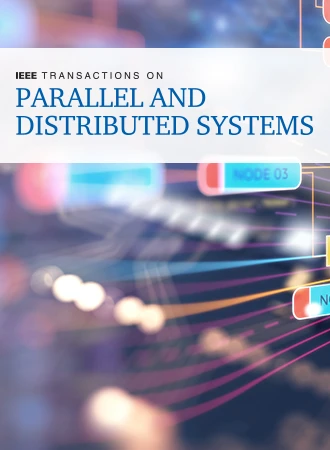GPComp:使用GPU和SSD-GPU Peer to Peer DMA加速键值存储的LSM-Tree压缩
IF 6
2区 计算机科学
Q1 COMPUTER SCIENCE, THEORY & METHODS
IEEE Transactions on Parallel and Distributed Systems
Pub Date : 2025-07-07
DOI:10.1109/TPDS.2025.3586616
引用次数: 0
摘要
基于lsm树的键值系统广泛用于许多internet应用程序,以其优越的写性能而闻名。压缩操作负责维护lsm树的金字塔存储结构,以确保可接受的读性能,这构成了严重的性能瓶颈。高性能ssd和轻量级用户空间文件系统在LSM存储中的应用缓解了IO带宽瓶颈,但在KV较小和中等的情况下,这会增加压缩的计算资源消耗,将瓶颈从IO转移到计算上。为了缓解压缩的计算瓶颈,我们提出了GPComp,一种gpu加速压缩策略,用于具有轻量级用户空间文件系统的高性能ssd。GPComp具有高效的GPU压缩单元和CPU-GPU协同压缩加速策略。我们介绍了一个专门为LSM存储设计的用户空间文件系统,TopFS-GPU。它实现了基于spdd的SSD-GPU P2P IO堆栈,以提高gpu加速压缩中的数据传输吞吐量。它具有异步回写缓存策略,可在基于lsm树的键值系统中促进混合读写工作负载。此外,我们的流水线机制将GPU计算与SSD-GPU IO重叠,提高了系统吞吐量。GPComp基于LevelDB实现,平均写吞吐量提高了2.65倍,混合读写吞吐量提高了2.32倍,与最先进的方法相比,P99尾部延迟减少了169.65%。本文章由计算机程序翻译,如有差异,请以英文原文为准。
GPComp: Using GPU and SSD-GPU Peer to Peer DMA to Accelerate LSM-Tree Compaction for Key-Value Store
LSM-tree-based Key-value systems are widely used in many internet applications, known for their superior write performance. Compaction operations, responsible for maintaining the pyramidal storage structure of the LSM-tree to ensure acceptable read performance, pose significant performance bottlenecks. The application of high-performance SSDs and lightweight user-space file systems in LSM storage alleviates IO bandwidth bottlenecks, but it amplifies the computational resource consumption of compaction when KV is small and medium, shifting the bottleneck from IO to computation. To mitigate the computational bottleneck of compaction, we propose GPComp, a GPU-accelerated compaction strategy for high-performance SSDs with lightweight user-space file systems. GPComp features efficient GPU compaction units and a CPU-GPU cooperative compaction acceleration strategy. We introduce a user-space file system specifically designed for LSM storage, TopFS-GPU. It implements an SPDK-based SSD-GPU P2P IO stack to enhance data transfer throughput in GPU-accelerated Compaction. It features an asynchronous write-back cache strategy, facilitating mixed read-write workloads in LSM-tree-based key-value systems. Additionally, our pipeline mechanism overlaps GPU computations with SSD-GPU IO, increasing system throughput. Implemented based on LevelDB, GPComp shows up to a 2.65x increase in average write throughput and a 2.32x improvement in mixed read-write throughput, with a P99 tail latency reduction of up to 169.65% compared to state-of-the-art methods.
求助全文
通过发布文献求助,成功后即可免费获取论文全文。
去求助
来源期刊

IEEE Transactions on Parallel and Distributed Systems
工程技术-工程:电子与电气
CiteScore
11.00
自引率
9.40%
发文量
281
审稿时长
5.6 months
期刊介绍:
IEEE Transactions on Parallel and Distributed Systems (TPDS) is published monthly. It publishes a range of papers, comments on previously published papers, and survey articles that deal with the parallel and distributed systems research areas of current importance to our readers. Particular areas of interest include, but are not limited to:
a) Parallel and distributed algorithms, focusing on topics such as: models of computation; numerical, combinatorial, and data-intensive parallel algorithms, scalability of algorithms and data structures for parallel and distributed systems, communication and synchronization protocols, network algorithms, scheduling, and load balancing.
b) Applications of parallel and distributed computing, including computational and data-enabled science and engineering, big data applications, parallel crowd sourcing, large-scale social network analysis, management of big data, cloud and grid computing, scientific and biomedical applications, mobile computing, and cyber-physical systems.
c) Parallel and distributed architectures, including architectures for instruction-level and thread-level parallelism; design, analysis, implementation, fault resilience and performance measurements of multiple-processor systems; multicore processors, heterogeneous many-core systems; petascale and exascale systems designs; novel big data architectures; special purpose architectures, including graphics processors, signal processors, network processors, media accelerators, and other special purpose processors and accelerators; impact of technology on architecture; network and interconnect architectures; parallel I/O and storage systems; architecture of the memory hierarchy; power-efficient and green computing architectures; dependable architectures; and performance modeling and evaluation.
d) Parallel and distributed software, including parallel and multicore programming languages and compilers, runtime systems, operating systems, Internet computing and web services, resource management including green computing, middleware for grids, clouds, and data centers, libraries, performance modeling and evaluation, parallel programming paradigms, and programming environments and tools.
 求助内容:
求助内容: 应助结果提醒方式:
应助结果提醒方式:


